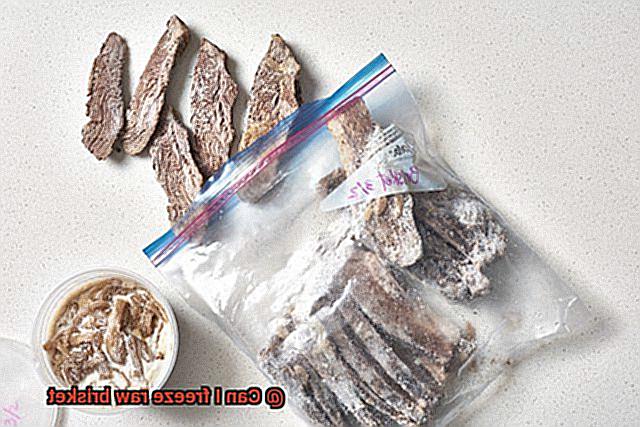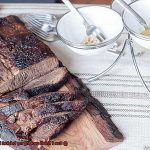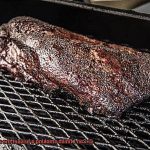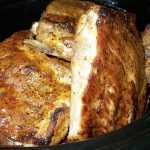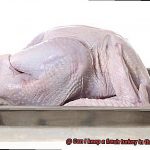Got some extra raw brisket and not sure what to do with it?
You’re not alone. Many of us have found ourselves in this situation, wondering if we can freeze that juicy slab of meat for later use.
Well, wonder no more. In this blog post, we’ll tackle the age-old question: Can you freeze raw brisket?
So, if you’re itching to know whether your brisket can survive a deep freeze, keep reading for all the juicy details.
Contents
What is Raw Brisket?
If so, raw brisket is a cut of meat that should be on your radar. In this comprehensive guide, we will unveil the mysteries of raw brisket, from understanding its essence to choosing the perfect piece, and even exploring the possibility of freezing it for future enjoyment. So put on your apron and let’s embark on this flavorful journey.
What is Raw Brisket?
Raw brisket is the untamed form of beef that hails from the cow’s lower chest or breast region. It is a tough yet tantalizing cut that requires patience and slow cooking methods to transform into a succulent masterpiece. When venturing into the realm of raw brisket, you will encounter two distinct types: packer’s cut and trimmed cut. Packer’s cut includes both the flat and point cuts, accompanied by a generous layer of fat known as the fat cap, which ensures moistness during cooking. Trimmed cut, in contrast, has undergone a fat-removal process, resulting in a leaner piece of meat.
Choosing and Storing Raw Brisket:
Purchasing raw brisket involves seeking vibrant red hues, minimal odor, and firm textures. The market offers various sizes, but keep in mind that brisket tends to shrink while cooking. If you plan to satisfy a crowd or relish leftovers, opt for a larger portion to satiate those appetites.
Can You Freeze Raw Brisket?
Indeed, you can freeze raw brisket. Freezing allows for time-saving convenience and extends the meat’s shelf life. To execute this process flawlessly, enshroud the raw brisket in airtight packaging such as heavy-duty plastic wrap or freezer bags. Expel excess air to prevent the dreaded freezer burn and take the extra step of labeling it with the freezing date. Store this treasure trove of flavor in the coldest section of your freezer, preserving its unrivaled quality.
Thawing and Cooking Frozen Raw Brisket:
When the time comes to thaw frozen raw brisket, prioritize safety by placing it in the refrigerator for 24-48 hours. Alternatively, if you find yourself pressed for time, utilize the defrost setting on your microwave. Once thawed, cook the brisket immediately to halt any bacterial growth. Avoid refreezing previously frozen raw brisket, as it can detrimentally impact its texture and taste.
Benefits of Freezing Raw Brisket
The benefits of freezing raw brisket for grilling are truly remarkable. Let’s explore why freezing this delicious cut of meat can be a game-changer for convenience, quality, and even saving money.
- Extended Shelf Life: Freezing raw brisket prevents it from spoiling, allowing you to buy in bulk and take advantage of great deals at the store. No more worrying about your meat going bad before you have a chance to use it.
- Maintained Quality and Flavor: When brisket is frozen properly, it retains its tenderness and juiciness. Thawing and cooking frozen brisket still results in a delicious meal every time.
- Better Meal Planning: Freezing raw brisket allows for easy meal planning. Whether you’re a busy individual or a family on the go, having frozen portions or whole cuts on hand means you can defrost and prepare the exact amount you need, whenever you need it. No more last-minute trips to the store or scrambling to find fresh meat.
- Stress-Free Events: Hosting a barbecue or special event? Freezing raw brisket ahead of time is a total game-changer. You can have a ready supply of meat without the stress and hassle of last-minute shopping and preparation. It’s like having your own secret stash of deliciousness waiting to be grilled to perfection.
- Reduced Food Waste: Instead of letting leftovers go to waste, simply freeze them for later use. Every bite counts, and freezing ensures that no delicious piece of meat goes uneaten.
- Enhanced Flavor Infusion: Freezing raw brisket gives you the opportunity to marinate it before freezing, allowing those flavors to infuse into the meat as it thaws. Talk about a time-saver. No need to wait hours for your meat to marinate – it’s already done.
- Culinary Creativity: Freezing raw brisket opens up a world of possibilities for experimenting with different cooking methods and recipes. Go ahead, try that new marinade or rub without worrying about wasting fresh meat if the results aren’t what you expected. With frozen raw brisket, you can let your culinary creativity run wild.
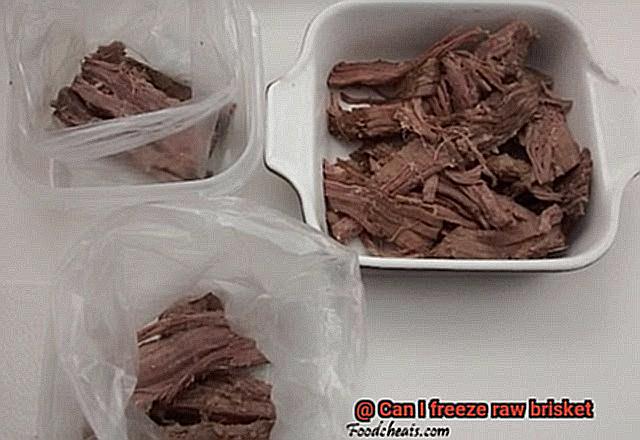
Selecting and Preparing the Raw Brisket for Freezing
Well, I’ve got a secret for you – freezing raw brisket. It’s like having your own treasure chest of deliciousness in the freezer. But before we get too excited, let’s talk about selecting and preparing that brisket for freezing.
First things first, find the best brisket possible. Look for a well-marbled piece of meat, it’ll stay tender and juicy during freezing. And freshness is key. Avoid briskets that have been sitting in the store for too long.
Now it’s time to give that brisket some love. Trim off excess fat, leaving about 1/4 inch thickness to keep it moist while freezing. Nobody wants a dry brisket. And let’s not forget the seasoning. Whether you prefer a dry rub or marinade, coat that brisket evenly on all sides. Let it marinate in the fridge for a few hours before freezing for maximum flavor.
Your perfectly trimmed and seasoned brisket is ready to be wrapped up tight. Start with plastic wrap, covering every nook and cranny. Then wrap it again in aluminum foil or use a freezer-safe bag or container. Label with date and contents for easy identification later.
Now pop that wrapped brisket into the coldest part of your freezer. Aim for a temperature at or below 0°F (-18°C) to ensure quick and thorough freezing. If you’ve got a big brisket, divide it into smaller portions for easier thawing and cooking later.
Packaging for Freezing Raw Brisket
Packaging for freezing raw brisket is a crucial step to ensure the quality and longevity of the meat during storage. Proper packaging helps to prevent freezer burn, maintain flavor, and preserve the texture of the brisket. Here are some important points to consider when packaging raw brisket for freezing:
- Wrap it securely: Give your brisket a warm embrace by tightly wrapping it in either plastic wrap or aluminum foil. This first layer of protection shields it from the harsh elements of the freezer, preventing dreaded freezer burn. Seal those edges and eliminate any gaps – we want that brisket to be as cozy as possible.
- Double layer for extra love: Take it a step further (and who wouldn’t?) by adding a second layer of packaging. Place the wrapped brisket in a freezer-safe resealable plastic bag or vacuum-sealed bag. This additional barrier provides extra protection against air and moisture, ensuring your brisket stays in tip-top shape.
- Say goodbye to excess air: Just like superheroes, our brisket needs to breathe, but not too much. When using a resealable plastic bag, give it some wiggle room but remove excess air before sealing. Air can be a sneaky villain, causing freezer burn and ruining our beloved brisket’s quality. Use a straw or vacuum sealer to suck out that air and create a tight seal.
- Labeling – the secret ingredient: Don’t forget to give your frozen treasure a name and date. Labeling the package with the freezing date is key. Trust me, you’ll thank yourself later when rummaging through your freezer trying to find your precious brisket. Plus, it helps you keep track of how long it’s been stored so you can gobble it up within the recommended time frame for ultimate deliciousness.
- Divide and conquer: If you have a behemoth of a brisket, consider dividing it into smaller portions before freezing. This allows you to thaw only what you need, saving time and effort. Smaller portions also freeze and thaw more quickly and evenly, ensuring every bite is as tender as the next.
- The perfect resting place: Once your brisket is snugly packaged, find it a cozy spot in the coldest part of your freezer. Resist the temptation to place it near the freezer door – that area is prone to temperature fluctuations that could disturb the tranquility of your brisket. Keep it on the back or bottom shelf, where the coldness reigns supreme.
Storing Frozen Raw Brisket
Grill masters know that the secret to a mouthwatering barbecue lies in the perfect cut of brisket. But what happens when you can’t fire up the grill right away? Freezing raw brisket is a convenient storage option that allows you to enjoy the rich flavors of this meat whenever you’re ready.
Here, we’ll explore the crucial steps of packaging, labeling, and temperature control to ensure your frozen raw brisket stays fresh and delicious. Get ready to elevate your grilling game.
The Power of Packaging:
- Wrap it Right: Shield your brisket from dreaded freezer burn by wrapping it tightly in heavy-duty aluminum foil or freezer paper. This forms a protective barrier against air and moisture, preserving its savory taste.
- Double-Wrap for Extra Protection: For maximum freshness, consider double-wrapping your brisket. This additional layer of insulation ensures that freezer burn stays far away from your precious meat.
Labeling – Your Secret to Organization:
a. Date It: Don’t let your brisket get lost in the icy depths of your freezer—label the package with the date of freezing. This simple step helps you keep track of how long it has been stored, ensuring you use it within a safe timeframe.
Temperature Control:
- The Chill Zone: Set your freezer temperature at a cool 0 degrees Fahrenheit (-18 degrees Celsius) or below. This optimal storage condition guarantees that your raw brisket maintains its quality.
- Finding the Perfect Spot: Place your wrapped brisket in the coldest part of the freezer, such as the back or bottom shelf. This strategic placement ensures a consistent temperature and prevents any unwanted fluctuations that could affect the meat’s quality.
Thawing with Care:
- Slow and Steady Wins the Race: Plan ahead and allow ample time for gradual thawing in the refrigerator. This method preserves the texture and taste of your brisket, so it’s worth the wait.
- Safety First: Avoid thawing raw brisket at room temperature or under hot water. These methods can encourage bacterial growth and compromise food safety.
Cook it Up:
Once thawed, cook your brisket promptly to avoid any potential risks. Refreezing thawed raw meat can lead to a loss of quality and increase the risk of foodborne illnesses.
Defrosting and Cooking Frozen Raw Brisket
Defrosting and cooking frozen raw brisket can be a culinary adventure that leads to a mouthwatering and tender meal. The process involves proper thawing techniques and choosing the right cooking method for your preferences and available equipment.
When it comes to defrosting, the refrigerator is your best friend. Slowly thawing the brisket in the fridge ensures a gradual thaw, preserving the meat’s quality and texture. To do this, place the frozen brisket in a leak-proof plastic bag or airtight container to prevent cross-contamination. It’s also a good idea to put it on a tray or plate to catch any drippings during the thawing process.
The time required for defrosting depends on the size and thickness of the brisket. As a general rule of thumb, allow approximately 24 hours for every 4-5 pounds of meat. Avoid rushing the process with hot water or a microwave, as this can result in uneven thawing or potential bacterial growth.
Once your brisket is fully thawed, it’s time to choose your cooking method. Here are a few options:
- Smoker or Barbecue Pit: Slow cooking in a smoker or barbecue pit allows the flavors to develop slowly over hours, resulting in a tender and flavorful brisket. Maintain a consistent temperature and monitor the internal temperature to ensure it reaches a safe cooking temperature.
- Oven Roasting: If you don’t have access to a smoker or barbecue pit, oven roasting is an excellent alternative. You can choose to cook at a lower temperature for longer cooking times or crank up the heat for quicker results.
- Braising: For faster cooking, consider braising. Sear the brisket first to develop a beautiful crust, then cook it in a liquid (such as broth or wine) at low heat until tender.
Regardless of your chosen method, make sure to season your brisket before cooking. Whether it’s a dry rub or a marinade, let the flavors infuse into the meat for a few hours or even overnight.
After cooking, let your brisket rest for a few minutes before slicing. This allows the juices to redistribute throughout the meat, resulting in a tender and flavorful final product.
Potential Risks of Freezing Raw Brisket
Imagine this: a perfect day, and your mouth is watering at the thought of that succulent, melt-in-your-mouth brisket you’ve been fantasizing about. But hold on. Your hectic schedule leaves no time to prepare it fresh. What’s the solution? Freezing raw brisket for grilling. Yet, before embarking on this freezing adventure, it’s vital to understand the potential risks lurking in the icy depths. Let’s delve into these pitfalls and discover how to conquer them.
Texture Troubles:
Freezing can be a merciless thief, robbing your brisket of its tender glory if not handled with care. Improper wrapping or sealing can lead to moisture loss, transforming your dreamy meat into a dry and chewy nightmare. To safeguard that tantalizing tenderness, ensure your brisket is cocooned tightly, minimizing exposure to the treacherous air.
Beware of Freezer Burn:
Ever opened your freezer, only to behold a pitiful, frost-covered slab of meat? That’s the dreaded freezer burn – an unsightly spectacle with an equally unappetizing taste. Ice crystals form on the meat’s surface, causing moisture to evaporate and leaving behind a desolate texture. Foil this foe by vacuum-sealing your brisket or employing airtight containers to keep air at bay.
Flavor Fiasco:
While freezing won’t launch a taste revolution in your brisket, subtle flavor changes may tiptoe in unnoticed. The discerning palate might detect a slight divergence between fresh and frozen meat. Fear not. This impact is minimal and won’t sabotage your grilling escapades.
The Bacterial Battlefield:
Freezing may slow bacterial growth, but it’s no battlefield victor. If your brisket wasn’t properly handled or stored before freezing, dangerous bacteria could still lurk within when thawed and cooked. To dodge this risk, ensure your meat is fresh and adhere to proper food safety guidelines.
Quality Quandary:
The essence of brisket lies in its tender, juicy allure. Regrettably, freezing can tinker with the meat’s structure, resulting in a texture that falls short of perfection after thawing and cooking. While it won’t spell disaster, it might not reach the lofty heights of your expectations.
Tips for Successful Freezing of Raw Brisket
Here, we’ll explore tips and techniques to successfully freeze raw brisket, ensuring that you always have a convenient and flavorful option for your next grilling session.
Prepare the Brisket:
Before freezing, take the time to trim any excess fat, silver skin, or connective tissue from the brisket. This not only improves the meat’s overall quality but also helps prevent freezer burn during the freezing process. By removing these unwanted elements, you’ll ensure that your brisket stays tender and flavorful even after it has been frozen.
Wrap it Right:
To protect the brisket from moisture loss and freezer burn, tightly wrap it in plastic wrap or aluminum foil. Make sure there are no air pockets or gaps in the wrapping to prevent the formation of ice crystals. The goal is to create a barrier that seals in the juices and prevents any moisture from escaping or entering the package.
Choose Proper Packaging:
Opt for freezer-safe packaging materials like heavy-duty plastic bags or vacuum-sealed bags. These provide an extra layer of protection against freezer burn and help maintain the meat’s quality and flavor. Vacuum-sealing removes all air from the package, further preserving the freshness of the brisket. If using plastic bags, squeeze out as much air as possible before sealing them tightly.
Store Smartly:
Keep raw brisket at a consistent temperature of 0°F (-18°C) or below in a separate compartment or section of your freezer. This minimizes the risk of cross-contamination and ensures optimal conditions for the meat. It’s recommended to place the brisket in the coldest part of the freezer, such as the back or bottom shelf, to ensure quick and even freezing.
Thaw with Care:
When it’s time to thaw your frozen raw brisket, do so slowly in the refrigerator. Allow sufficient time for larger cuts to thaw completely, preserving moisture and texture. Avoid thawing at room temperature or using hot water, as these methods compromise food safety. Thawing in the refrigerator ensures a gradual thawing process that maintains the quality of the meat.
fXe1YUQ3SN0″ >
Conclusion
Yes, you can absolutely freeze raw brisket.
Freezing this delectable cut of meat not only allows you to conveniently store it for later use, but it also helps to lock in its juicy flavors and tender texture. By placing your raw brisket in airtight packaging or freezer bags, you can ensure that it stays fresh and free from freezer burn.
So go ahead and stock up on this mouthwatering delight – your future self will thank you when you’re craving a delicious brisket meal without the hassle of defrosting.

